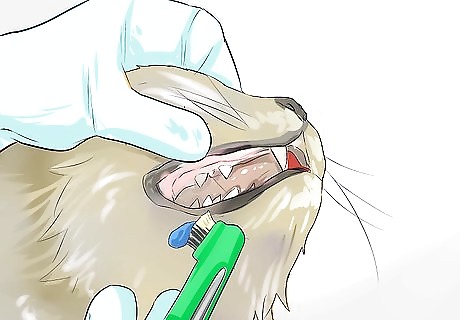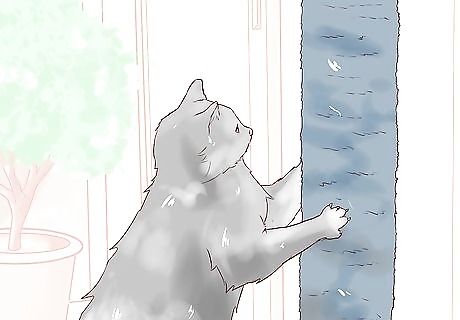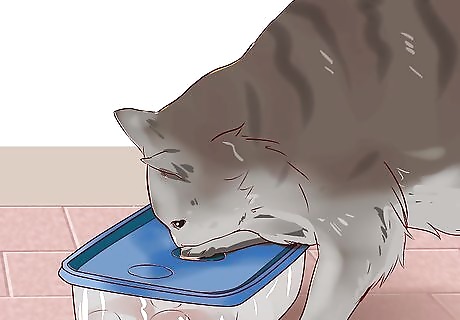
views
X
Trustworthy Source
Cat Fancier's Association
World's largest registry of pedigreed cats and organization devoted to the well-being of all cats
Go to source
If you have a Norwegian forest cat, then you will need to know all about the best way to feed, groom, entertain, and provide veterinary care for your cat.
Feeding Your Norwegian Forest Cat

Select a high-quality cat food. Keeping Norwegian forest cat in peak physical condition requires some high-quality cat food. Take care to choose a high-quality cat foot that will meet all of your Norwegian forest cat’s nutritional needs. One good way to select a food for your cat is to read the ingredients. The first two ingredients listed on the package should be meat (not meat by-products). If they are not, then keep looking. Choose a food that contains taurine. Taurine is an essential amino acid that your cat needs for good vision and heart health. All high-quality cat foods should include this ingredient, so avoid any cat foods that do not contain taurine.

Feed your Norwegian forest cat two measured meals per day. Free-feeding is when you allow your cat to have access to unlimited food. This way of feeding causes some cats to become overweight, so it is not the best method. Instead, feed your Norwegian forest cat a measured amount on a regular schedule. To determine how much to feed your Norwegian forest cat, take the daily recommended feeding amount on your cat’s food package and then divide this amount in half. For a cat that weighs between five and nine pounds, you may need to provide a daily amount of 2/3 of a cup. To divide this amount into two meals, give your Norwegian forest cat 1/3 of a cup in the morning and 1/3 of a cup at night. Providing small portions will make it more likely that your cat will eat her food. Check with your Norwegian forest cat’s veterinarian for a specific recommendation on how much to feed your cat.

Provide lots of fresh, clean water for your Norwegian forest cat. Your Norwegian forest cat will need to have a bowl of fresh, clean water available at all times. Wash your cat’s water bowl daily and change the water once per day or as needed. Your cat’s food and water bowls should be placed somewhere that is easy for your cat to access. Never place food and water bowls near your cat’s litter box. Cats do not like to eat and drink near their litter boxes.

Give your Norwegian forest cat treats. Norwegian forest cats like treats like all cats do, so try to give your Norwegian forest cat a special treat once per day. You can buy special kitty treats in the grocery store or pet store. You might also try giving your cat some acceptable human foods as a treat. Remember that treats should not exceed 5% of your Norwegian forest cat’s total daily calories. Some good treat options include: lean deli meat cooked chicken or turkey canned tuna cantaloupe chunks steamed broccoli cheese cooked eggs mashed potatoes homemade tuna cat treats
Grooming Your Norwegian Forest Cat

Brush your Norwegian forest cat’s fur weekly. Even though Norwegian Forest cats have long fur, they do well with weekly brushing. Use a wire bristle brush or comb to brush your Norwegian forest cat’s back, sides, tummy, chest, and tail once per week. If you start brushing your Norwegian Forest cat when she is a kitten, then this process will be much easier for both of you.

Trim your Norwegian forest cat’s claws. Your Norwegian forest cat needs his claws, but sometimes your cat’s claws may become too sharp and you may have to give him a trim. If your cat uses his scratchers often, then you may not need to trim his claws at all. If your cat does not use his scratchers too often, then it is a good idea to trim your Norwegian forest cat’s claws once every three weeks. Trim the white tips of your cat’s claws only. Avoid the pink area of your Norwegian forest cat’s claws. Cutting this part of the claw can hurt your cat. You should be able to see the pink area of your cat’s claws when you look at them in the light. Use a special guillotine style nail trimmer and only trim a little bit of your cat’s claws at a time. The goal of a trim is to cut off the sharp tips, not remove your cat’s entire claw.

Clean your Norwegian forest cat’s teeth. Regular dental care is a good way to keep your Norwegian forest cat’s teeth healthy, which is important for his overall health. Regular brushing will also help to keep your cat’s breath fresh. To brush your Norwegian forest cat’s teeth, use a toothbrush and toothpaste that is meant for cats. Human toothpaste can make your cat sick. Introduce your Norwegian forest cat to the toothbrush gradually. For example, you may begin by letting him to lick wet cat food off of the toothbrush for the first few days and then try to put the toothbrush into his mouth after he seems comfortable with it. When you brush your Norwegian forest cat’s teeth, use gentle strokes along the surface of his teeth and gums. Do not apply too much pressure or you may injure him.

Bathe your Norwegian forest cat if necessary. Norwegian forest cats have thick, double coats that are waterproof, so giving him a bath might be a challenge and you may want to consult a professional groomer if you think a bath is necessary. Keep in mind that you should not need to bathe your Norwegian forest cat unless he gets dirty or sticky. If you notice that your Norwegian forest cat suddenly stops grooming himself, then take him to see the veterinarian before you do anything. This may be a sign of illness.
Providing Comfort and Veterinary Care

Give your Norwegian forest cat a soft bed. Your Norwegian forest cat will sleep about as much as the average cat, so he will need a comfortable bed. Find a comfortable bed for your Norwegian forest cat and place it somewhere that he likes to nap. For example, if you have noticed that your cat takes a lot of naps near a specific window, then try placing his bed near that window.

Put up scratching posts for your Norwegian forest cat. Norwegian forest cats need to scratch, so it is important to provide your cat with an appropriate outlet for scratching. Corrugated cardboard scratching boards and rope wrapped boards work well. Try placing a few of these scratching posts throughout your home. If you notice your Norwegian forest cat scratching something that is off limits (couch, carpet, etc.), do not yell, hit him, or throw something at him. Just pick up your cat gently and place him right next to one of his scratching posts. You might even try placing his paw on the board to show him that he can scratch it. With time, he will understand that these are for scratching and other things are not for scratching. To make scratching posts even more attractive, sprinkle a bit of catnip on and around them.

Provide enough litter boxes for your Norwegian forest cat. Your Norwegian forest cats will use litter boxes if they are clean and available. Scoop litter boxes daily and change the litter once per week. Some other good ways to encourage good litter box habits include: Ensuring there are enough litter boxes. You need at least one more litter box than your total number of cats. For example, if you have two cats, then you need to have a minimum of three litter boxes. Using fine-grained litter. Cats seem to prefer fine-grained litter in their boxes. Choose a clumping litter variety to make it easier for you to clean the box. Filling the box to the right level. Cats do not like litter that is too deep, so try to fill the box so that there is only about two inches of litter.

Take your Norwegian forest cat to visit a veterinarian. Norwegian forest cats need regular veterinary exams just like all other cats do. Take your Norwegian forest cat to see a veterinarian as soon as possible after you get him and then take him for regular veterinary visits once every year. During your cat’s veterinary visits, your cat will get a physical exam, get tested for diseases (such as feline leukemia), and receive vaccinations (like a rabies vaccination). Maintain annual visits and take your Norwegian forest cat to see a veterinarian you ever suspect that he is sick.

Spay or neuter your Norwegian forest cat. If you do not plan to breed your Norwegian forest cat, then you should have your cat spayed or neutered. Spaying and neutering helps to control the pet population and protects your pet from some health conditions and behavioral problems. Talk to your Norwegian forest cat’s veterinarian about spaying or neutering as soon as possible to prevent bad behavior from setting in. Cats that are not spayed or neutered are more prone to behaviors such as spraying, aggression, and roaming. If you wait too long to spay or neuter your cat, then these habits may cause long-term behavioral issues. Spaying and neutering can also protect your Norwegian forest cat from certain health issues, such as enlarged prostate, uterine infections, and certain forms of cancer.
Entertaining Your Norwegian Forest Cat

Pet your Norwegian forest cat. Norwegian forest cats are independent but loving breeds. They love affection from their humans, but they also require space sometimes. Try to give your Norwegian forest cat attention when he is in the mood for it. For example, if your Norwegian forest cat climbs onto your lap, then this is a good sign that he is in the mood for some affection.

Give your Norwegian forest cat a puzzle toy. Norwegian forest cats are intelligent and they enjoy challenging toys. Try giving your Norwegian forest cat puzzle toys that will challenge him and stimulate his mind. Puzzle treats also offer your cat a treat when he solves the puzzle, so this may be even more fun for him.

Try hunting-instinct toys with your Norwegian forest cat. Your Norwegian forest cat will enjoy playing with other types of toys as well. Norwegian forest cats have a long history of hunting, so look for toys that will engage your cat’s predator instincts. For example, you might try: fur mice electronic toys chirping bird toys wand toys


















Comments
0 comment